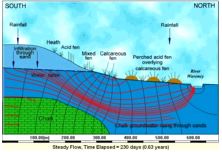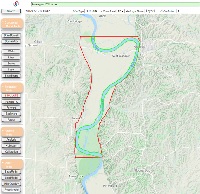|
|
|
Surface & Ground Water Interaction
|
|
|

|
|
Stream Aquifer Interaction
(Lesson - Under Development) Beginner. This exercise explores the impact of stream stage fluctuations on adjacent aquifer systems (both unconfined and confined). Part I involves qualitatively describing the key parameters and relationships controlling groundwater response to stream fluctuations through the analysis of (vertical cross-section) profile models. Part II presents the mathematical framework of stream-aquifer interaction, giving students the opportunity to quantify groundwater dynamics and infer aquifer properties from observational data.
(Surface & Ground Water Interaction- 8)
|
|

|
|
Losing Streams vs. Gaining Streams
Gaining streams are supplied with water from groundwater, and losing streams lose stream water to groundwater. Therefore gaining streams have water flowing year‐round or for extended periods such as wet seasons, whereas losing streams tend to have flow only in response to water‐input events like rainfall and otherwise have no flow. Watch the following MAGNET videos and answer the questions that follow.
(Surface & Ground Water Interaction- 8)
|
|

|
|
Groundwater vs Surface Water-fed Lakes, Flow Through Lakes
nder most situations, groundwater and surface water are hydraulically connected. A lake, stream, or wetland either receives water or provides water to the underlying aquifer in the form of bed or bank seepage. In some cases, a lake or wetland can both simultaneously receive water from and provides water to the aquifer below.
(Surface & Ground Water Interaction- 8)
|
|

|
|
Bank Seepage & Springs
Bank Seepage is the natural diffuse discharge of groundwater into a river or lake along its banks. If concentrated in a particular area, a seepage may more accurately be called a spring.
(Surface & Ground Water Interaction- 8)
|
|

|
|
Flow Through Lakes
Flow-through lakes are surface expressions of the water table and are in direct hydraulic connection with the water-table aquifer. They receive inflows from groundwater along the upgradient shore of the lake and discharge flow to groundwater along the downgradient shore. In general, the net contribution of groundwater to the overall lake water balance is zero (although some net loss of groundwater from evaporation may take place).
(Surface & Ground Water Interaction- 8)
|
|

|
|
Water Withdrawal Assessment
When pumping near a stream, we are interested not only in the resulting drawdowns, but also in the depletion of the stream flow, resulting in potentially adverse impact of groundwater dependent ecosystems. Develop a more general MAGNET numerical model that can reproduce the above analytical solution and perform a sensitivity analysis of stream depletion with respect to the following parameters: aquifer conductivity; storage coefficient; regional hydraulic gradient; stream bed leakance; heterogeneity; presence of other interacting sources and sinks.
(Surface & Ground Water Interaction- 8)
|
|

|
|
Missouri River Alluvial Groundwater Problem
This lesson uses information from the Missouri River alluvial valley on the lower reaches of the River and groundwater modeling to explore in more detail how water flowing in one of the world’s largest rivers interacts with its adjacent groundwater.
(Surface & Ground Water Interaction- 8)
|
|
|
|